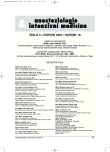-
Medical journals
- Career
Extended immunologic profile taken during the first days in the ICU and the prognosis of patients requiring long-term intensive care
Authors: L. Dadák 1; M. Štouračová 2; P. Štětka 1; P. Kuklínek 2; V. Šrámek 1
Authors‘ workplace: Anesteziologicko-resuscitační klinika Fakultní nemocnice u svaté Anny v Brně 1; Ústav imunologie a alergologie Fakultní nemocnice u svaté Anny v Brně 2
Published in: Anest. intenziv. Med., 18, 2007, č. 3, s. 164-169
Category: Intensive Care Medicine - Original Paper
Overview
Objective:
To establish the predictive value of an extended spectrum of immunologic parameters measured during the initial ICU days on the ICU survival of patients requiring long-term intensive care.Design:
Prospective, clinical study.Setting:
Department Anaesthesia and Intensive Care, St. Anna University Hospital, Brno, Czech Republic.Material and methods:
The immune profile was taken in patients estimated to stay in the ICU > 3 days in 5 - day intervals. In this paper we report on the trends of TNF-alpha production of the whole blood after LPS stimulation (TNF-alpha), plasma IL-6 and IL-10 concentrations and T-lymphocyte activation (CD3+HLADR+) in the first 5 days of ICU stay. The relationship of the immunologic parameters to ICU mortality, type of admission (surgical, medical, trauma, CPR) and APACHE II is also reported.Results:
167 patients were studied [M/F 113/54; mean age 63 (53; 73) years]. 137 survived their ICU stay (S) and 30 died (NS). APACHE II on admission was 27 (21; 33). On day 1 the production of TNF-alpha differed in the S and NS groups [> 1000 pg/ml (752; > 1000) and 870 pg/ml (542; > 1000) respectively; p < 0.05] as did the IL-10 concentration [6.2 pg/ml (5; 18) and 19 pg/ml (5.4; 63) respectively; p=0.005]. In the patients remaining in the ICU on day 5 (n=125) the change in TNF-α between day 1 and day 5 (delta TNF-α) did not differ between the S and NS groups.There was no significant difference between TNF-alpha between the S and NS groups on day 5 [in group S TNF-alpha production increased from > 1000 pg/ml (752; > 1000) to > 1000 pg/ml (> 1000; > 1000) and in group NS from 870 pg/ml (542; >1000) to > 1000 pg/ml (785; > 1000)]. IL-6 decreased in the NS group more slowly and therefore a significant difference in concentrations on day 5 was measured (p = 0.001). In group S a decrease from 74 pg/ml (32; 178) to 29.8 pg/ml (14.1; 57.4) and in group NS from 88 pg/ml (34; 681) to 66.5 pg/ml (43; 109) was measured. Patients with TNF-alpha production < 1000 pg/ml on day 1 had significantly greater mortality (p < 0.05) as did those with IL-10 > 9.2 pg/ml on day 1 (p = 0.06) and day 5 (p = 0.09). IL-6 >75 pg/ml predicted ICU death. No clinically significant association was found between any immunologic parameter and APACHE II on ICU admission.Conclusion:
The extended immune spectrum (TNF-alpha production of the whole blood after LPS stimulation, IL-10 and IL-6 plasma concentrations) has a predictive value in the heterogeneous population of longterm ICU patients.Key words:
intensive – immunoparalysis – TNF-alpha – interleukin 6 – interleukin 10 – APACHE II – outcome
Labels
Anaesthesiology, Resuscitation and Inten Intensive Care Medicine
Article was published inAnaesthesiology and Intensive Care Medicine

2007 Issue 3-
All articles in this issue
- Altering the hemodynamics during abdominal aortic aneurysm repair by acute normovolemic hemodilution
- Early resuscitation of septic shock to different levels of arterial blood pressure
- Impact of addition of synbiotics (Synbiotic 2000 Forte) to enteral nutrition on the course of MODS, occurrence of sepsis, immune status and gut function in long-term critically ill patients
- Extended immunologic profile taken during the first days in the ICU and the prognosis of patients requiring long-term intensive care
- Monocyte activation during the first days in the ICU and survival in a heterogeneous group of patients requiring long-term intensive care
- Helium and its role in current medicine
- The evolution of airway management
- Anaesthesiology and Intensive Care Medicine
- Journal archive
- Current issue
- Online only
- About the journal
Most read in this issue- Helium and its role in current medicine
- The evolution of airway management
- Altering the hemodynamics during abdominal aortic aneurysm repair by acute normovolemic hemodilution
- Impact of addition of synbiotics (Synbiotic 2000 Forte) to enteral nutrition on the course of MODS, occurrence of sepsis, immune status and gut function in long-term critically ill patients
Login#ADS_BOTTOM_SCRIPTS#Forgotten passwordEnter the email address that you registered with. We will send you instructions on how to set a new password.
- Career

